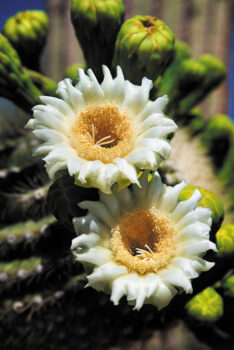
Saguaro buds and blooms (photo by Bob Hills)
Linda Shannon-Hills
The saguaro stands as a mighty sentinel presiding over the scorched earth of the Sonoran Desert. In late spring and early summer, you might see a crown of creamy-white blooms topping the body and the arms of the cactus. These are the blossoms of the Arizona state flower.
Most states have a state flower that comes from a colorful flowering plant, but Arizona’s state flower is unique—the creamy-white, waxy, and very fragrant blossom of the giant saguaro cactus.
The saguaro (Carnegiea gigantea) is the tallest cactus native to the United States. A 1-year-old saguaro is usually only one-quarter of an inch tall, and a 15-year-old saguaro may be under 1 foot tall. The Saguaro National Park studies have shown that a saguaro grows between 1 inch and 1.5 inches in the first eight years of its life. Once the saguaro attains some size, it begins to grow much faster. In the wild, the saguaro takes more than 100 years to be tall enough for an arm to develop.
Unlike a traditional flower, cacti only bloom once they have reached their full maturity level, which can take 75 years or more to occur. Reaching more than 12 feet tall, the saguaro can live over 200 years.
In mid to late April, areoles begin to swell on the saguaro, and soon it thrusts up the plant’s first buds. On the top of the saguaro’s trunk and arms sprout a profusion of buds. Once the buds begin to bloom, the blooms will only open up during the cooler desert nights and close again by midday. A saguaro may have hundreds of blooms over a months’ time.
The creamy-white saguaro flowers are about 3 inches wide with yellow centers. A dense group of yellow stamens forms a circle at the top of the tube of the saguaro cactus. The sweet scent of the saguaro flowers can smell of melons, which attracts bees and flies through the blooming season.
For the blossoms to develop into fruits, they must be pollinated during blooming. Pollination is carried out by nectar-feeding bats, birds, and insects.
For a cactus to bloom, the conditions must be exactly right. Water plays a major role along with light exposure and fertilization to trigger its blossoming maturity. A single cactus can have multiple blooms, creating a beautiful display of crowning flowers over 12 feet high.
The roots of the saguaro are shallow and extend out farther from the plant to gather more water during rainstorms, and it has a larger stem to manufacture more food through photosynthesis. When the saguaro plant absorbs water, the outer pulp of the saguaro can expand like an accordion, increasing the diameter of the stem and, in this way, can increase its weight by up to a ton. This storage capability aids during drought conditions.
By July, what’s left of the bloom becomes a red-fleshed edible fruit that feeds doves migrating to Mexico, other wildlife, and can be eaten raw by humans. The fruit has a red pulp and black seeds, which are prolific, up to 4,000 on a single fruit. From a distance, it looks like a red flower on the saguaro. The fruit has long been used by the Papago and Pima Indians who harvest the fruits to make syrups and jam.
The saguaro cactus is native to the Sonoran Desert. First adopted in 1901 as a territorial flower, the saguaro cactus blossom has been a part of Arizona’s history since the 1800s. The blossom made its first appearance as an Arizona symbol in 1836 as a proposed state seal. Richard Cunningham McCormick, who was the first Secretary of the Arizona Territory before it was a state, designed this seal. Arizona did not become an official state until 1912, and they officially recognized the saguaro cactus blossom as the state flower in 1931.
